CHAPTER 4
NATURALLY FACETED RAINBOW CRYSTALS
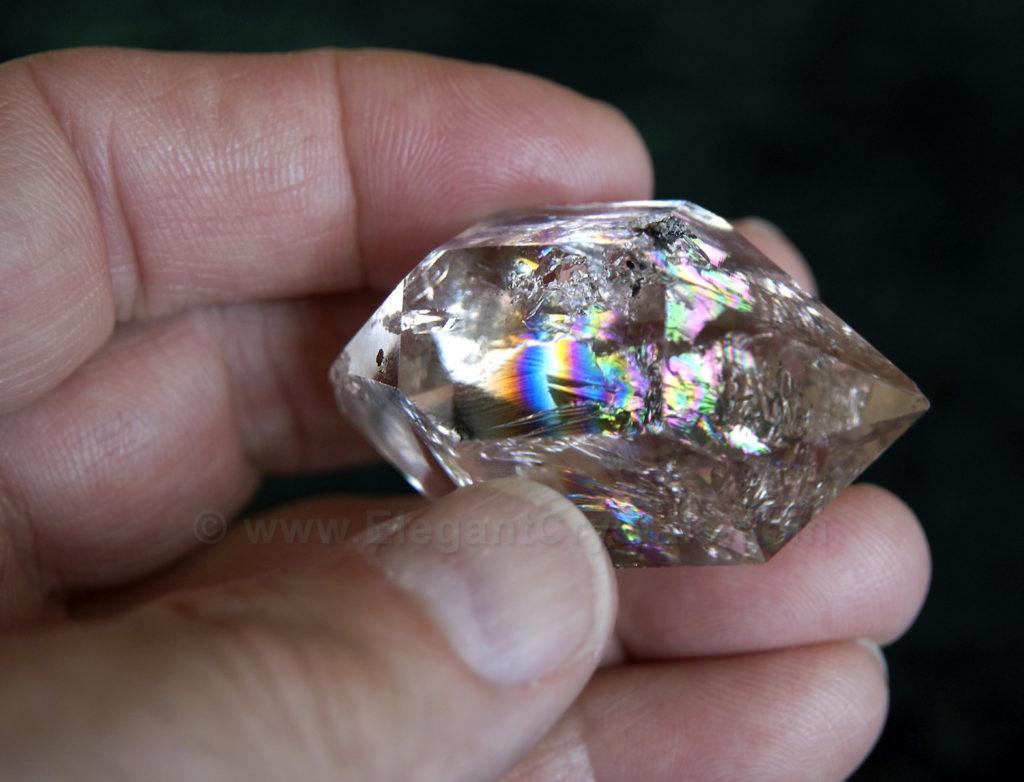
Picture #68
2-inch-long Herkimer County, New York Quartz
Silicon dioxide, SiO2
Courtesy of Sha-Ren
Above and beyond all the other stones, I feel quartz crystals create the most abundant, colorful and visible rainbows in the mineral kingdom.
The so-called “Herkimer Diamonds” often look like the best diamonds found in the ground.
However, there is no carbon – like diamonds have – in the Herkimer crystals.
They are pure quartz, no matter how diamantine/adamantine they look.
Natural diamonds mostly look like shiny pebbles.
In contrast, Herkimer quartzes have six smooth sides on the shaft and six flat triangles on each tip, for a total of 18 facets.
These are known as double-ended or double-terminated crystals.
(Also, double-ender or DT)
The stunning rainbows in Herkimer quartz are affected by several circumstances during growth.
These iris rainbows show colors OR transparency OR silver reflections at different viewing angles.
The inclusions are visually lively – a combination of colors and sparkles.
The shapes in the crystal change into rainbow sheets of color when you angle the stone to the light shining from over your shoulder.
Moving the crystal alters the colors instantly.
This is the process called “iridescence,” from the Latin root words:
“Rainbow Becoming”
I would like to be iridescent.
What about you?
Check out the photo at the end of chapter 13, book 9, for my next best vision.
Then come visit me in California someday, and I will light you up like a giant rainbow.
I will take pictures for you, showing your glowing rainbow being.
Would you like a movie of yourself dancing in rainbow light?
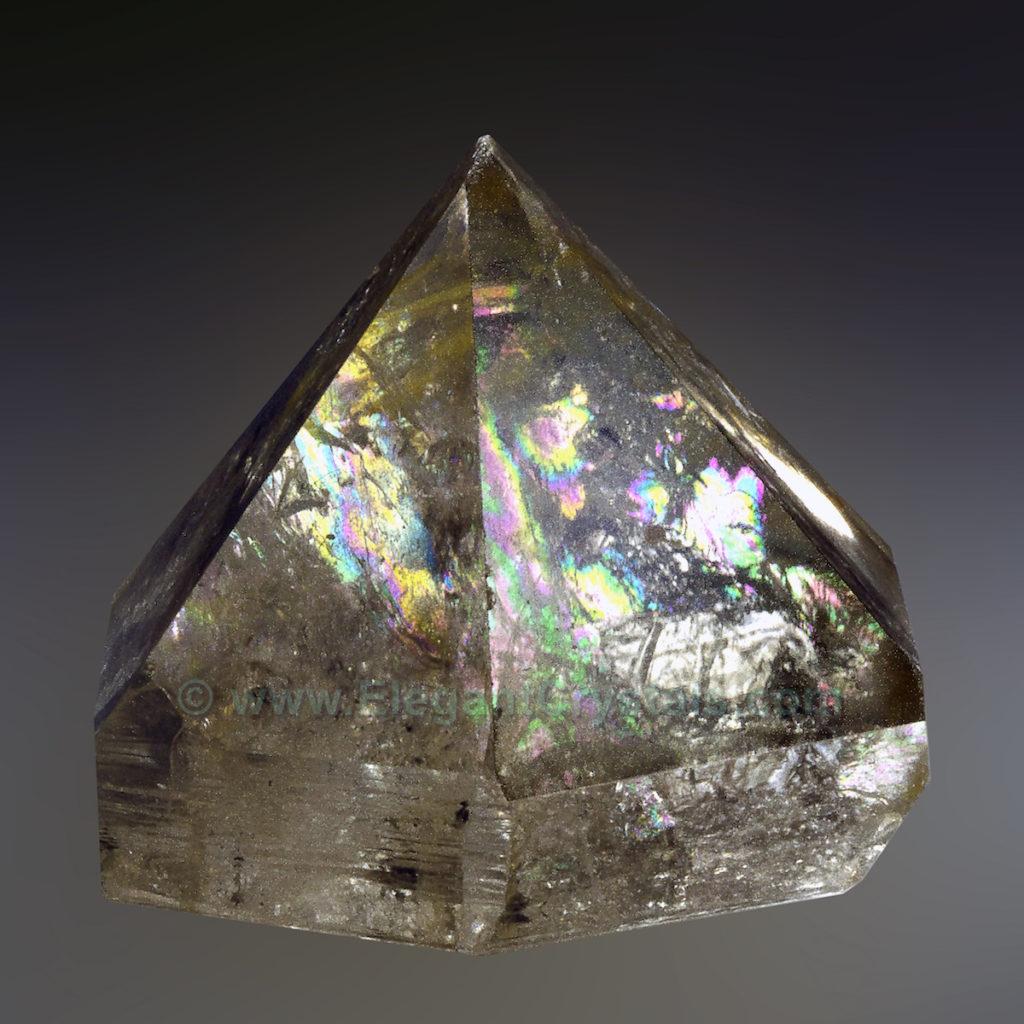
Picture #69
2-inch-long Herkimer County, New York Quartz
Silicon dioxide, SiO2
The Herkimer crystals have a special status in the world of quartz collectors.
A limited number of these fine crystals come out of the ground in Herkimer County, New York, as well as the county next door: Montgomery County, New York.
Oddly enough, magnificent quartz crystals also come from Montgomery County, Arkansas.
Let’s take a look at the difference amongst crystals from these two states.
Arkansas quartz is called “alpha-quartz” because it grows/forms at a lower temperature than New York’s “beta crystals.”
Since the beta crystals start out hotter than the alpha quartz, when they cool off, they shrink more.
This contraction creates the amazing iris fissures/cracks that exhibit the best rainbows.
The de-light-full stone shown here has a lot of personal history for me.
It was gifted to me in 1979 by my then-girlfriend Sheila.
She bought it on a road trip, at a flea market, for one dollar!
I used it as a memory device and meditation stone while I studied for the California Attorney’s Bar Exam.
I imagined I recorded all my notes in different parts of the crystal, using it as a solid-state storage device.
The information is encoded by a directed-memory process: associating the different spatial inclusions, rainbows and striations with different study topics.
The sheets of rainbows acted like CD discs that psychically stored the thousands of pages of law notes that I had to review and memorize.
This crystal comforted me in times of stress, and definitely helped me pass the 18-hour lawyer’s exam with “flying colors.”
Of course, I still have it in my collection.
It is my inter-dimensional legal reference library.
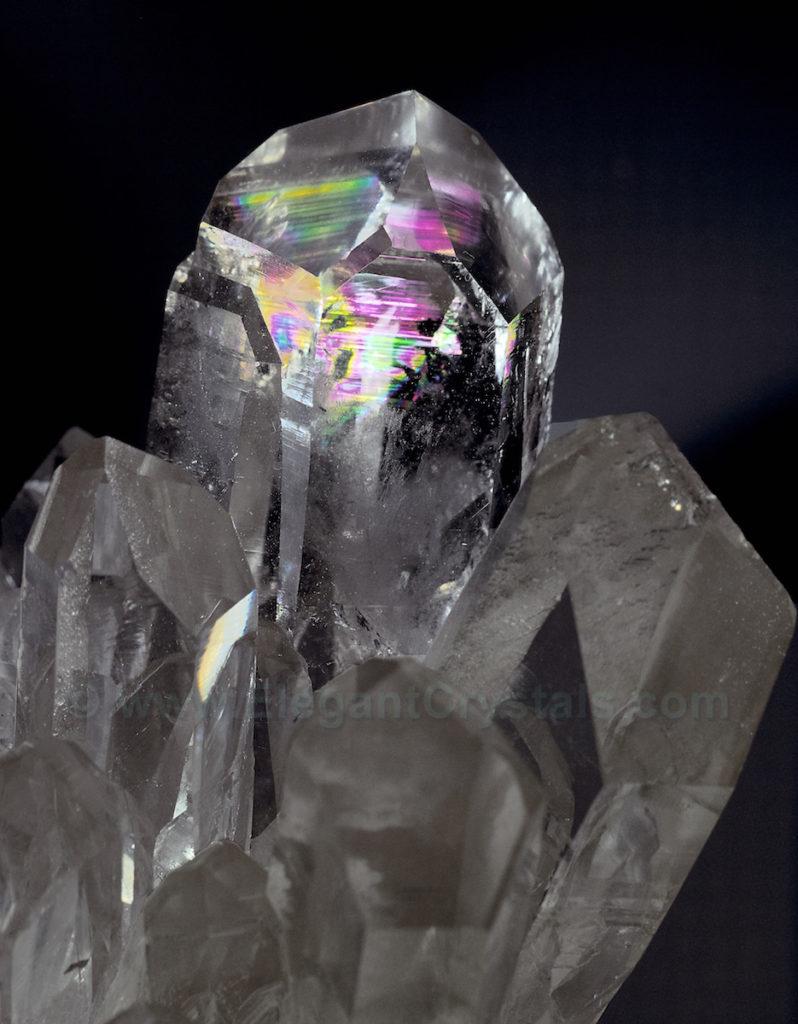
Picture #70
6-inch-long Brazilian Quartz Cluster
SiO2 – Silicon dioxide, Silica
Here is a stunning little group of ice-clear crystals.
Technically, these are described as being “water-clear” since ice normally has lots of bubble inclusions inside.
These gems are more-than-clear enough to see parallel lines – called striations – on all sides, even though the crystal.
When the striations are located between two pieces of quartz, lovely rainbows can appear.
In this all-natural, unpolished cluster, the rainbows are shining through nine adjacent facets. (crystal faces)
It is such a treat to see a great rainbow through even one facet at a time, let alone inside nine windows.
As the colors appear through more facets, it creates a great kaleidoscopic effect.
Six-sided iris quartz is THE natural ancient kaleidoscope from the mineral kingdom.
I like to find rainbows right under the tip that show through many facets.
Then I spin the crystal for a wonderful multi-colored light-show.
We’ll look at some more striated rainbows later.
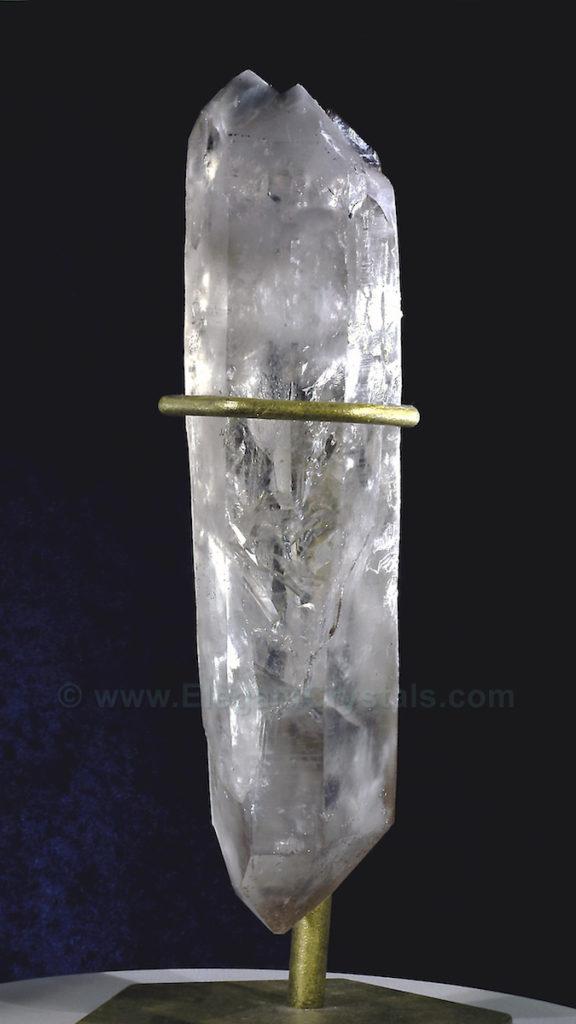
Picture #71
10-inch-tall Double-ended Quartz from Madagascar
Initially, this one looked like a bad candidate for iris rainbows.
It has swirling layers of white mist and purple-tinted clay growing under all 18 facets.
The surfaces are not clear and shiny, like so many of my favorites.
However, this unpolished piece of quartz does have intriguing little glimpses of color in it.
Frosty facets have limited visibility, so we often polish them to create a clear window into the heart of the stone.
I just had to have one big face polished on this one, to see if there was a good rainbow inside.
I call this “selective polishing;” a way to improve the crystal’s visibility with minimal changes to its natural form and beauty.
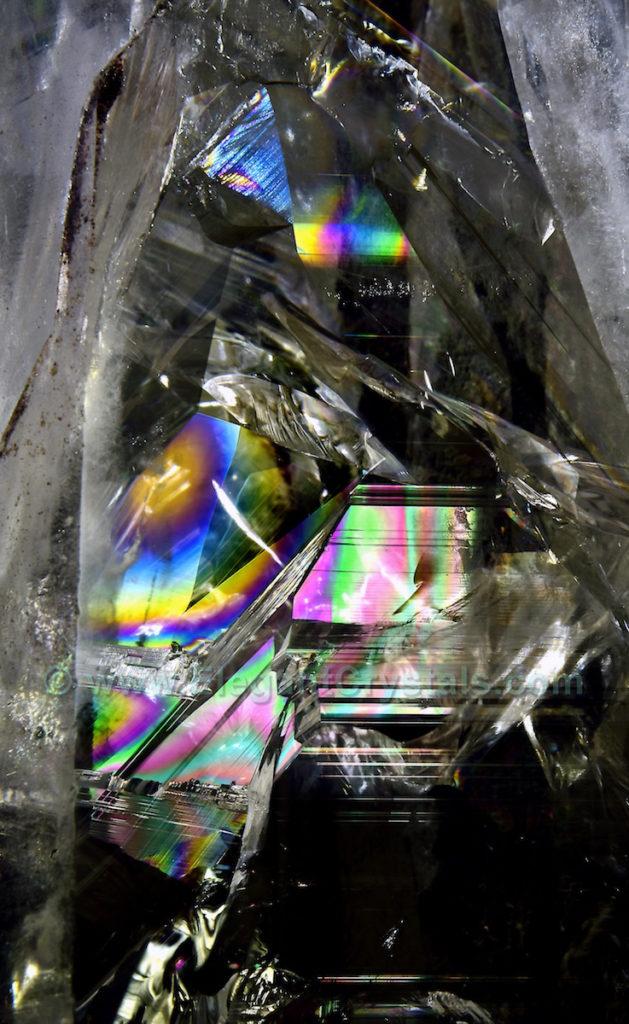
Picture #72
Closeup Image of a 10-inch-tall Double-ended Quartz from Madagascar
Perhaps you can imagine my surprise when we “opened up” the big front window on the previous crystal.
Stunning colors and repeating sheets of shimmering rainbows practically jumped out of the interior.
The crystal glowed with “first order” colors (blue, indigo and gold) as well as “third order” colors (pink and green).
In a later chapter, we’ll take a look at lots of these unusual color combinations.
They are so different from sky rainbows.
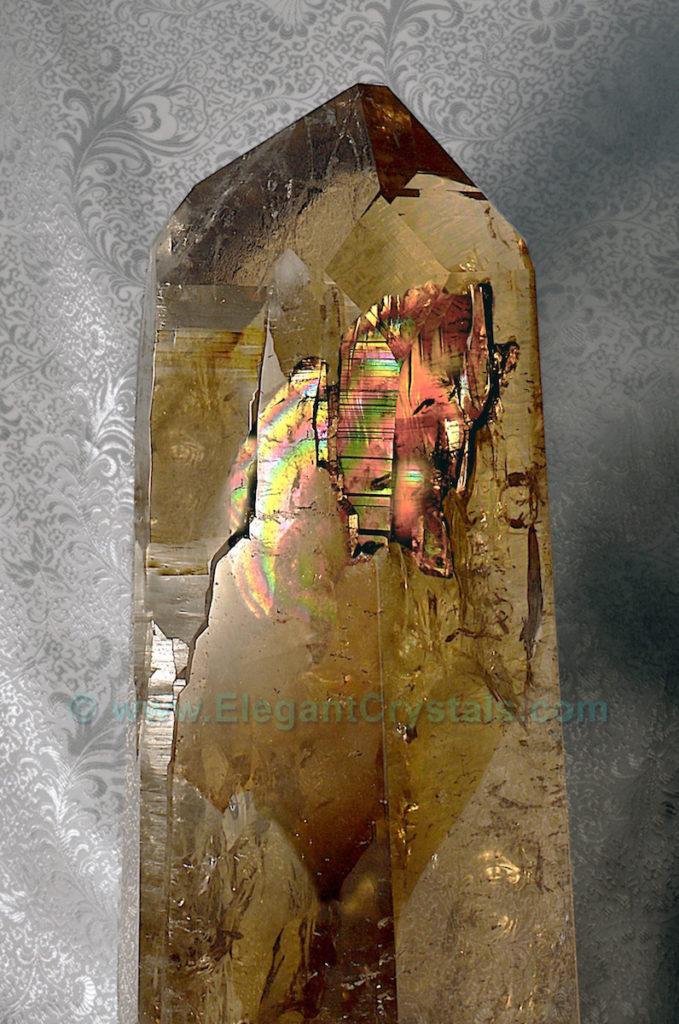
Picture #73
42-pound, 18-inch-tall Brazilian Citrine Quartz
SiO2 with Traces of Iron
I have been collecting and photographing quartz crystals since 1978, and selling them since 1981.
During this time, I always looked for the most interesting quartz rainbows that I could afford to buy.
Then I would take closeup still shots of the best color areas.
More recently, I created many videos of rainbow crystals rotating.
Each crystal sits on a high-precision motorized turntable for its moment under the spotlights.
You can see dozens of these rainbow videos by searching for my YouTube channel:
@CrystalRainbowBill1
Every year, I look at over a million crystals for sale, and I end up buying thousands of them.
These tons of crystals contain some iridescent specimens, but very few have “Mega-Rainbows.”
The crystal in this picture is one of my first Mega-Rainbows .
It contains enormous, flamboyant multiple rainbows.
It has seven distinct rainbows, each one between four and eight inches long.
They are huge!
That has to be some kind of a rainbow record, a spectral prize-winner.
I named it RAINBOWS!!!!!!!
Seven exclamation points- one per rainbow.
Please check out the next five pictures to see some of the fantastic colored patterns inside this crystal.
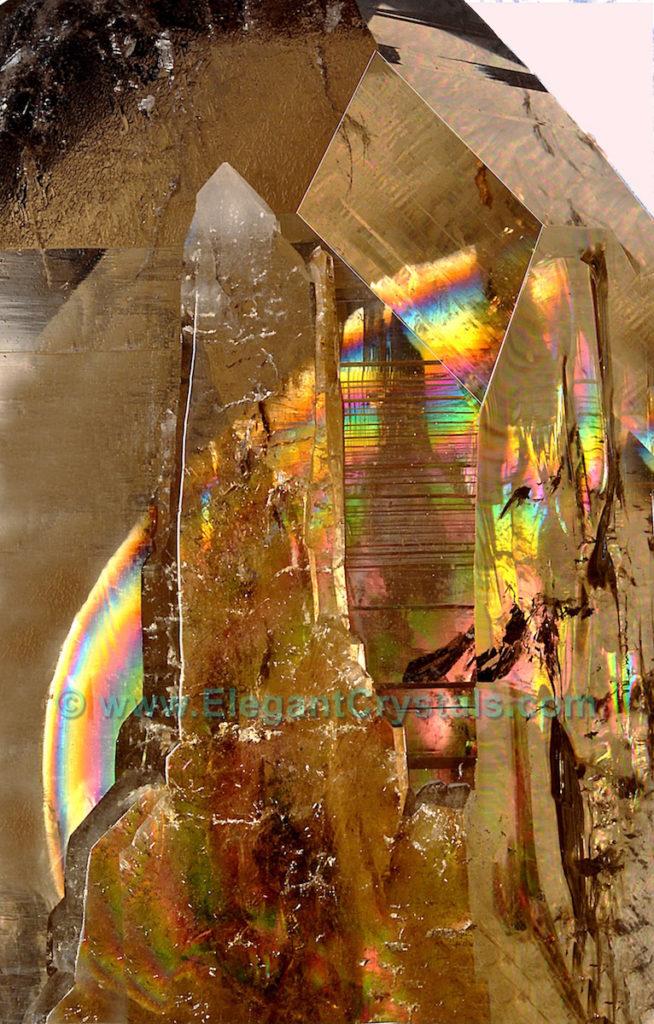
Picture #74
Details in a 42-pound, 18-inch-tall Brazilian Citrine Quartz
RAINBOWS!!!!!!! has a lot going on, just in this one photo.
Parallel crystals on the surface remind me of castle towers and turrets.
The rainbow arc inside is probably the closest in shape and colors to the rainbows we see in the sky.
This sheet-like rainbow effect is called “Newton’s rings” after Sir Isaac Newton, the first person to analyze it.
He was the first researcher to describe the mechanisms of a rainbow, which he famously separated with a glass prism.
Additional shades of pink and green fill the interior with subtly glowing smoky zones.
On the upper right, you can see a “diamond window” which is actually a seventh facet on a six-sided crystal.
I have never seen another diamond window this large; nor a diamond window with a rainbow arc behind it.
I think of this structure as a tiny stained-glass church, shining with the eternal Glory of the Divine.
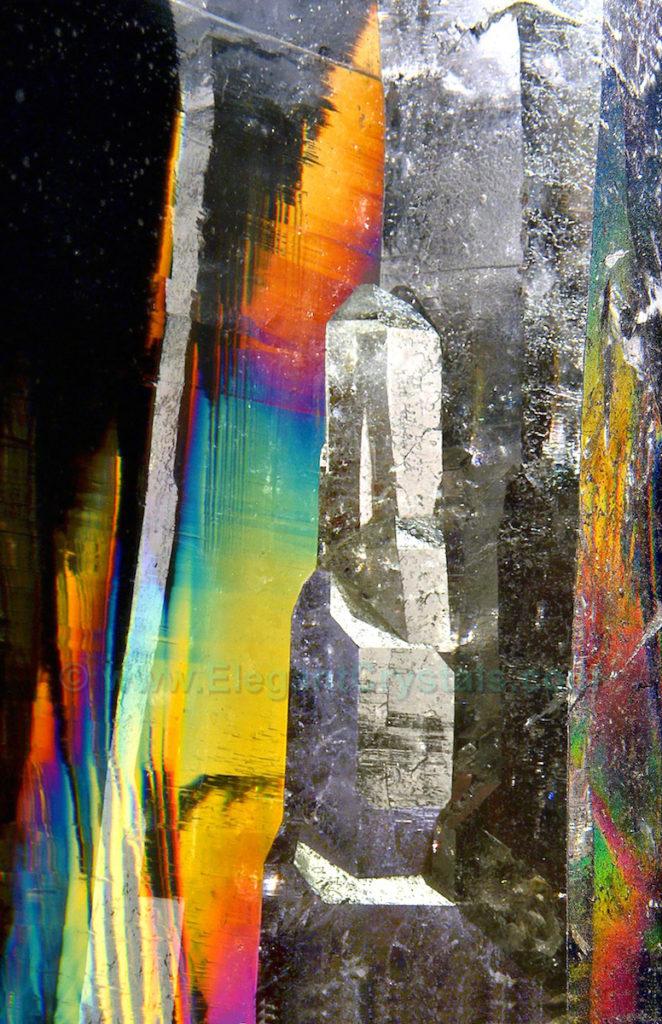
Picture #75
Details in a 42-pound, 18-inch-tall Brazilian Citrine Quartz
SiO2 with Traces of Iron
This citrine colossus has multiple towers gracing its sides.
Here is a 3-inch-tall architectural wonder nestled between two rainbows, which show through parallel facets on the crystal.
All the colors are reflections from the same interior rainbow which is refracted through two facets.
We’ll see lots of other images of quartz refraction later.
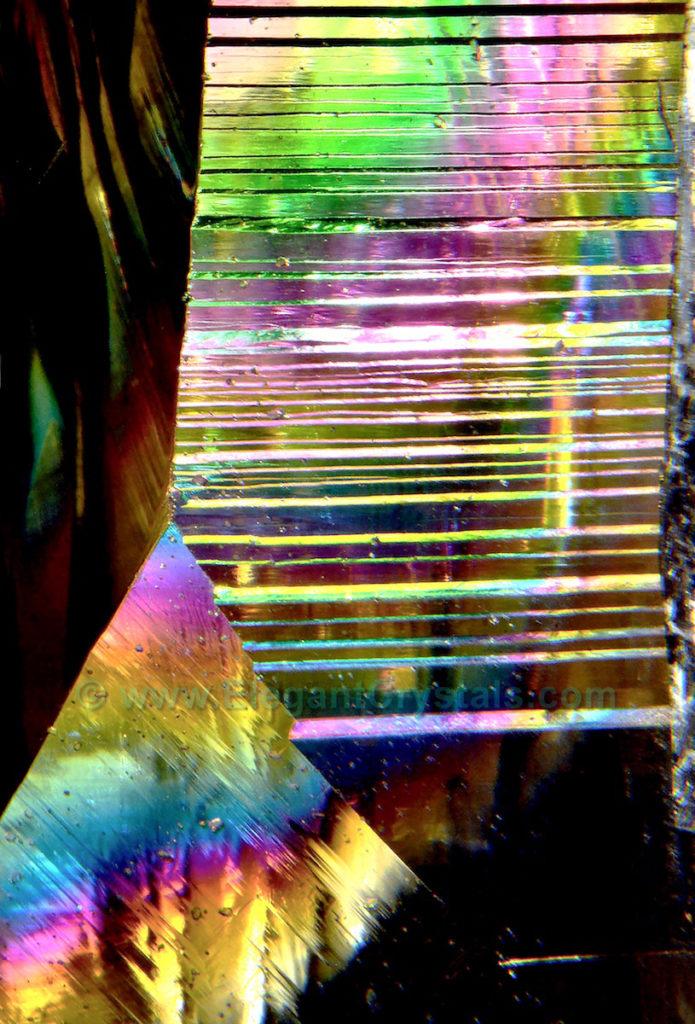
Picture #76
Details in a 42-pound, 18-inch-tall Brazilian Citrine Quartz
The diamond-shaped window in RAINBOWS!!!!!!!
shows a perfectly clear view of the colors underneath.
The wider lines on top look like window blinds to me, or perhaps the steps of a heavenly pathway.
The colored ladderlike area at the top looks very three-dimensional due to the alternating dark bands and color strips.
It is actually very smooth and probably too flat to feel with your fingertip.
The rows are only a few thousandths of an inch high.
Striation lines on the outside of a crystal usually appear as rows of parallel stripes.
These striations on the facets are perfectly clear rippling rows of silica molecules.
The existence of these lines tells me that the diamond window is an all-natural, unpolished facet.
It was not polished out by a clever crystal-cutter who was covering up a chip.
If a diamond window is totally smooth,
I would guess it was a repair and not an original untouched surface.
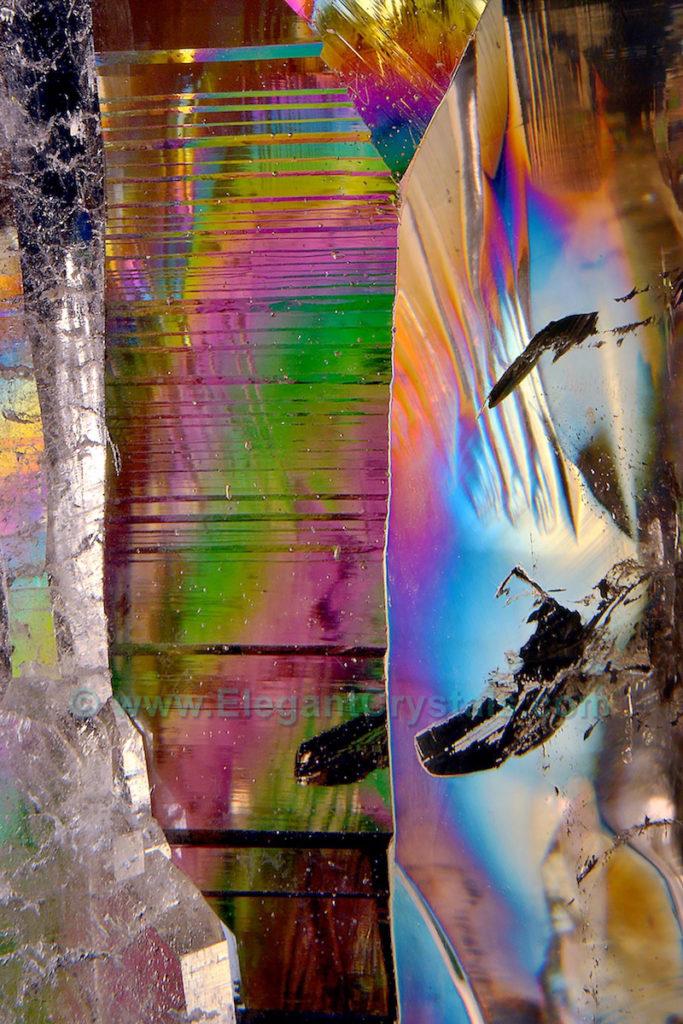
Picture #77
Details in a 42-pound, 18-inch-tall Brazilian Citrine Quartz
SiO2 with Traces of Iron
RAINBOWS!!!!!!! shows different color schemes when the prismatic fissures are viewed through adjoining sides.
This additional level of refraction changes not only the patterns, but also the types of colors and their intensity.
First-order colors are on the right; second order colors are on the left.
The “orders” of colors depends specifically on the size of the gap between crystal layers deep within the stone.
These thin gaps are sized very close to the thickness range of different colored human hairs.
Your hair is just about as thick as the colored light rays are long.
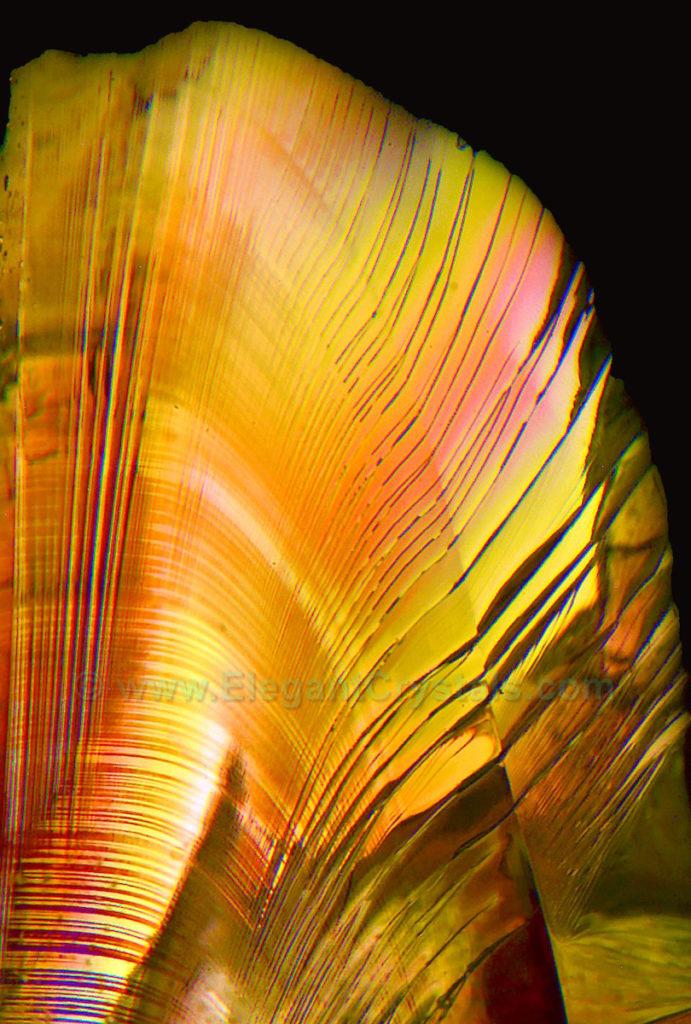
Picture #78
Details in a 42-pound, 18-inch-tall Brazilian Citrine Quartz
RAINBOWS!!!!!!! has ancient feathery patterns inside this 600-million-year-old citrine quartz crystal.
This detailed crystal wave developed over half-a-billion-years ago.
It is a slow-moving crack or cleavage or fissure that lengthened as the crystal became bigger.
It seems counterintuitive to think of a fracture like this NOT occurring instantly.
However, it took years for this pattern to expand to its present six-inch length as the crystal continued to grow around it.
As the fissure spread further, the molecules all crystallized into tiny flat rows.
The rows fanned out into its present feather shape over a growth period of hundreds of years.
Why is it so golden-colored?
The fissure is simply a neutral silvery color (dim white light), just like a mirror.
Because the quartz itself looks golden, the silver mirror takes on that warm golden tint.
At other viewing angles, these wavy patterns show up as full rainbow colors.
You can, in fact, see a hint of iridescent colors beginning to appear in this image.
